| 1 | Chiapas burrowing snake |
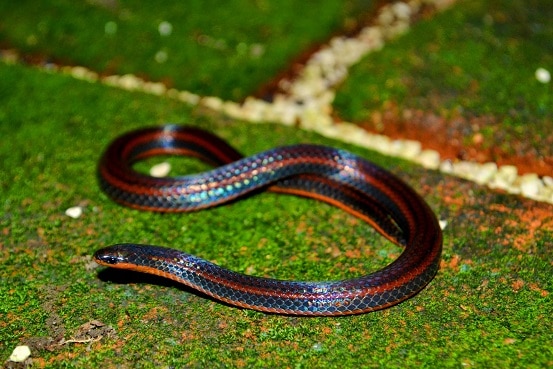
This harmless snake lives in the Chiapas highlands of Mexico, favouring milder bushy areas where locals might walk down established trails and see their heads poking out of grass. This species has all the essential friendliness requirements, with round black eyes and a slender head, rather than crinkled and cruel like a boa.
Chiapas burrowing snakes prefer heavily vegetated areas, but are sometimes drawn further into towns by the warm cement, only to forget how to return. Up close, their body has a glistening look, and they vary in colour, with some being pure black and others having a colourful orange belly. Chiapas burrowing snakes have no power to deal out deaths to humans, or even a painfully swollen hand.
Even a diehard ophiophobia sufferer might be able to approach this species. This snake is so friendly-looking that handling it could wipe out a fear of snakes for good, deleting it from your brain banks as though it had never existed. Its face is so friendly that there’s no way it could dream of harming you. On the other hand, some might find the cute expression scarier than if it was straight up angry looking – see the widespread fear of clowns. If this snake slithered past your picnic mat at 12 o’clock, you’d surely be less likely to have a heart attack compared to if it was a timber rattlesnake.
| 2 | Olive sea snake |
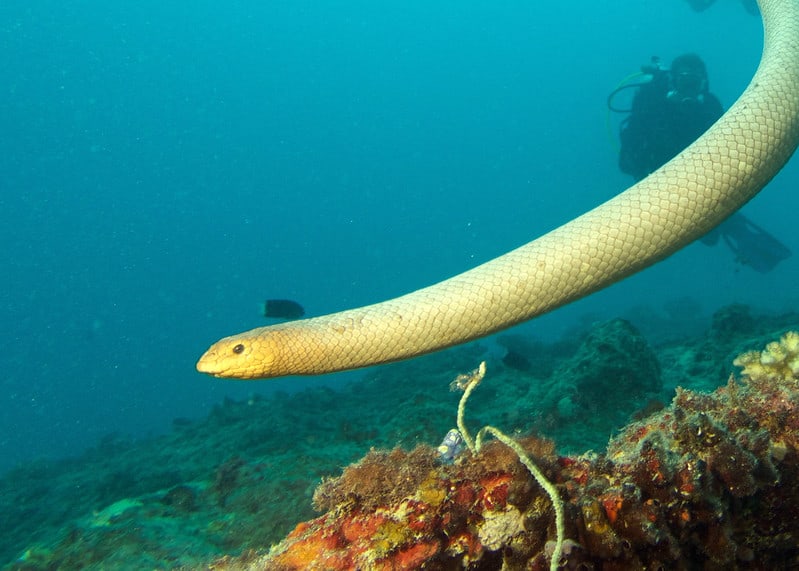
This species looks like it has a lovely personality and would do anything for a passing swimmer. The olive sea snake lives in coral reefs and open waters across Australasia. It has a peaceful, calm expression which looks like it could never wish ill on anyone. In this case it’s true, as this species almost never attacks humans.
Olive sea snakes have an extremely powerful venom which can sever all brain connections, bringing on paralysis in just one or two drops. However, they almost never use it, and the only confirmed victims were fishermen who scooped them up accidentally in nets. Olive sea snakes have golden beige scales, which are much more reassuring than a banded sea krait’s black and white. Their facial expression is enlightened, as though they hold millions of years of oceanic wisdom. An olive sea snake will even swim over and affectionately wrap itself around a scuba diver’s leg, although it’s believed that they’re mistaking them for females of their species.
Olive sea snakes eat fish exclusively, yet will choose from any category, from eels, to snappers to gobies. It’s perfectly safe to be mere metres from an olive sea snake, although don’t get so focussed on the snakes that you forget about the sharks.
| 3 | Usambara green snake |
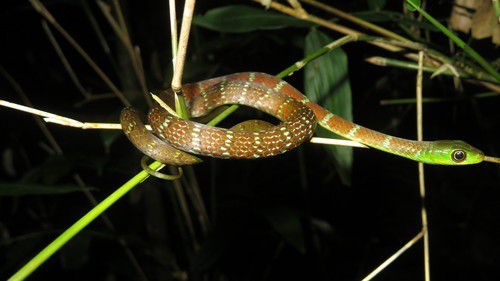
This friendly-looking snake has plenty of photographs to its name, but that’s about it. We know they exist, but nobody has ever analysed its personality and lifestyle in detail.
Usambara green snakes are native to the Usambara mountains of Tanzania, surrounded by a host of fellow jungle creatures, including Usambara eyelash vipers. They reach 95cm, have brown eyes, and are thought to prey on lizards and frogs. They have a thin body for skirting along branches, and look as though they’re very happy with this niche nature has given them. You can see this friendly (looking) creature by stopping and looking up, scanning the lower branches, but they sometimes grace the ground with their presence too.
If you’re trekking through the Usambara mountains (found in NE Tanzania) and see one in the bushes, it might be tempting to make it your new best friend. However, Usambara green snakes are virtually unheard of in captivity and nobody knows exactly how they might respond. They could be so calm that they coil up on your bed at night, joining your beloved collection of bears. But they could be vicious, bitey creatures which attempt to swallow you whole, realise they’re too small, before settling for your fingers.
| 4 | South American sipo |
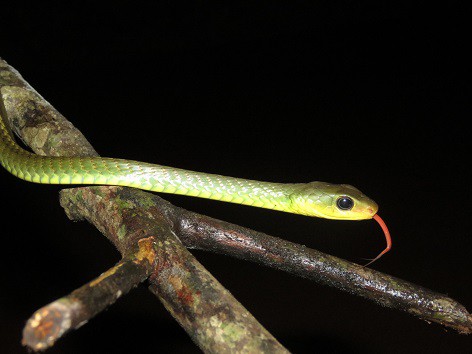
This species lives in Brazil, Peru, northern Venezuela and Columbia, where it’s one of the friendliest-looking snakes around, truthfully or deceptively. South American sipos (Chironius multiventris) live in forests both remote and local, and split their time between ground and branches. They lack any venom, and nor are they considered unusually vicious. They also appear near streams, slithering over boulders, in their determined quest to find frogs, their main prey. South American sipos are confirmed to eat ocellated treefrogs and Atlantic forest treefrogs.
This species varies naturally in appearance, and has a scale of cuteness. Some are bright green, while others are a far denser green which contrasts against a dark yellow belly. The consistent feature is their round and friendly eyes.
This snake is probably derided as a show off by its neighbours in the forest. Species they live alongside include the common lancehead and boa constrictor, both of which have cruel faces. Common lanceheads actually eat other snakes, and it’s possible that Chironius multiventris is one they pick on.
Cuteness is what the South American sipo does best, although they may have chosen differently if offered by the serpent gods. Or maybe they like being the Bambi of snakes; we don’t know. This species looks superficially similar to nearby sipos, but the simplest difference is purely technical – a far higher scale count on their belly. They reach decent branch heights, having been spotted at 4 metres above ground.
| 5 | Common green racer |
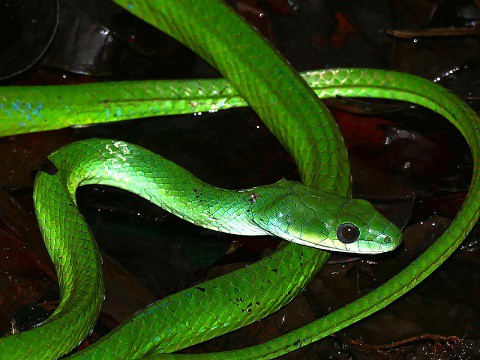
This is a medium-sized friendly snake of South America, reaching a maximum length of 140cm. It has the bulging round eyes, and unlike other large non-venomous snakes, you don’t get the feeling that it’s itching to slither over and start whipping you with its tail.
The common green racer (Philodryas viridissima) occupies forests, and moves through branches and ground just as effortlessly. They climb trees as easily as a pavement, and also invade human habitation: this one invaded an inn’s roof to grab two bats lurking in the darkness. Philodryas viridissima completes the cuteness quota with green scales, which are bright, but not so disturbingly bright that they must be deadly, and a benign, optimistic facial expression.
Of course, these features didn’t evolve to make them cute. In other animals, green scales and large eyes may be utterly terrifying. Each animal has a different mind and instincts. The things that humans find cute may be horrifying to birds, causing them to stop in mid air and fly away fast with a flapping of feathers. Common green racers also have a tendency to curl up in the centre of roads for thermoregulation – it’s possible that they wish to greet human drivers.
| 6 | Boomslang |
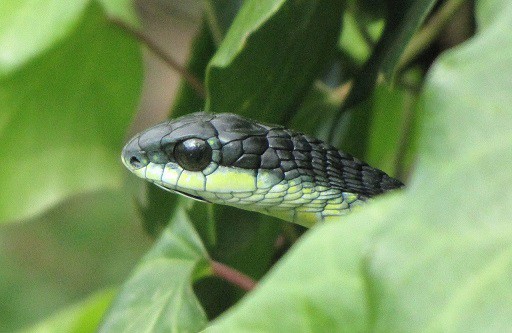
This friendly-looking snake is best viewed through the safety of binoculars. Though boomslangs look like they’d love to perform backflips to a crowd of admirers, or even give helpful tips about the weather, the reality is different: a venom which causes spontaneous bleeding all over the body. Of any of these “friendly” snakes, this is the one that could lull you into a false sense of security, thinking they’re a harmless tree snake. The boomslang very rarely strikes, but when they do, they give no warning (unlike a rattlesnake).
The boomslang barely seems to have an iris; the pupil and rest blend together into black balls like a cartoon. Likewise, via a fluke of evolution, the scales around their mouth are arranged to create a permanent expression of calm and benevolence. None of this has any connection to their real personality.
Boomslangs live in trees, but prefer tree clumps in mixed areas, even in villages next to roads. They have a particular taste for chameleons, with a decent side helping of frogs. They’re rare in captivity due to their venomous ways, though this hasn’t deterred some adoring keepers who think they’re misunderstood.
| 7 | Speckled racer |
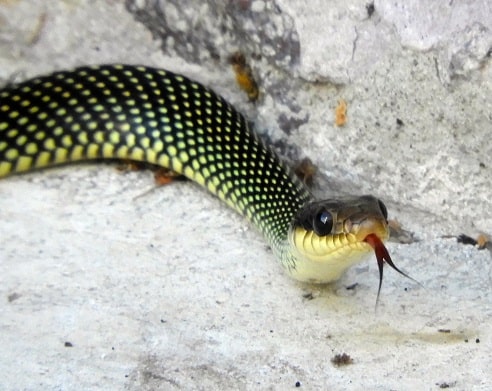
A relative of Costa Rica’s black forest racer, but with the cuteness dial turned further to the right. Speckled racers have green scales overlaid with vivid black, which are dazzling like disco lights. Their eyes have a dark brown iris, and they lack any venom.
This snake lives in varied habitats, from forests to grassland to savannahs to people’s back gardens. They move almost exclusively by day, rarely venturing forth in moonlight. In fact, the vast majority of cute snakes on this list are diurnal, AKA day-faring. This isn’t a coincidence, but has a sound explanation: diurnal snakes generally have round pupils, with a few exceptions. Disney knows well that round eyes are an important part of the cuteness equation.
The opposite is also true. Whether logical or not, making a snake’s pupils vertical immediately increase its menace levels 5-fold. The same would work for a human being. So the facts are that the most brutish, thuggish snakes are more likely to prowl at night, while by day, your forest will be more of a fairytale-esque wonderland. That said, speckled racers may look friendly, but they’re not that peaceful. They have an unpredictable temperament and can rapidly turn bitey if they feel they’re cornered. This is one of the deceptive friendly snakes.
| 8 | California kingsnake |
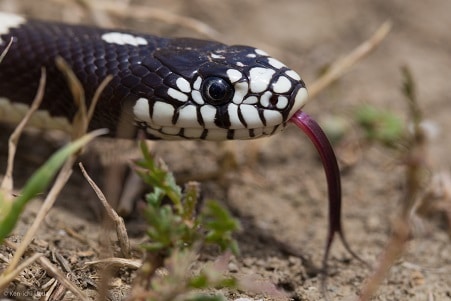
This western US species is a popular captive snake, partly because of its friendly appearance. The California kingsnake (Lampropeltis californiae) is an independent species which inhabits dry arid areas with cacti and rocky canyons. It measures 75-100cm, and looks friendly thanks to round black eyes, a calm expression, and smooth scales.
This doesn’t prove what’s happening in their mind, but the California kingsnake is a harmless, non-venomous species which constricts its prey. In captivity, they easily adjust and rarely bite at the keepers attempting to fling them mice.
If you had to choose a snake to meet in the desert, this would definitely be preferable over a Mojave rattlesnake. The only non-friendly characteristic is their crushing skills. The boa constrictor beats them for raw squeeze force as measured by PSI (pounds per square inch), but the California kingsnake is a stronger constrictor in proportion to its size. In fact, it’s one of the strongest snakes on Earth. They couldn’t kill, yet they might give your wrist the squeezing of a lifetime if they felt like it. If lost in the desert, a California kingsnake is more likely to nudge at you to wake you up than try to kill you.
| 9 | Mojave shovel snout |
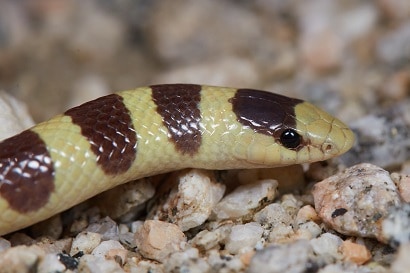
The Mojave shovel snout is a slightly venomous species, which inhabits deserts of Arizona, Nevada, California and northern Mexico. They spend most of the day burrowing through sand, or hiding in shaded areas beneath dry vegetation. They’re also spotted crossing remote desert highways at night, and with their friendly appearance, this is probably one of the least terrifying to meet. This is clearly no cruel, cunning viper. The Mojave shovel snout (Sonora occipitalis) has round, completely black eyes, and bright colours like the decorations of a fancy chocolatier. This snake’s expression is one of curiosity rather than aggression.
This snake is just as friendly-looking up close as they are from a distance. There’s no horrifying effect where you walk closer in wonder, only for cuteness to be replaced by a vicious grin. If frightened, they may perform mock strikes, but their mouths are too tiny to inject venom properly. The venom itself is too weak to have any effect.
Mojave shovel snouts live up to their friendly appearance with their personality (mostly). This species reaches a maximum of 43cm.
| 10 | Laotian wolf snake |
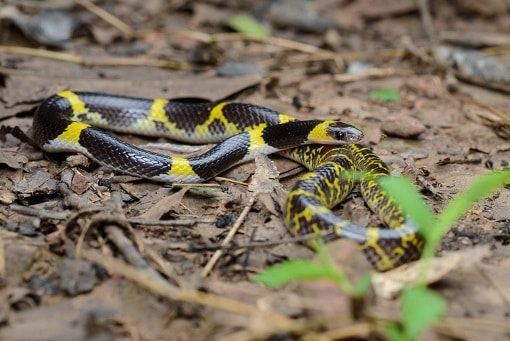
The Laotian wolf snake appears intermittently in forests across Cambodia and Vietnam, also wandering into human households. They stick to the ground, and are completely harmless, with neither paralysing venom nor ferocious bite.
With its bright eyes and calm facial expression, the Laotian wolf snake looks like a peaceful forest guardian, which may be unable to speak but can send telepathic messages to lost travellers. Their mouth is too small to bite humans, and with their main predators being birds, we probably barely register as a threat anyway. Laotian wolf snakes feed on geckos and are particularly common in National Parks in mountainous or hilly regions (such as Cat Tien National Park). They’re strongly yellow-black and average at 50cm.
Whether the Laotian wolf snake realises that it’s far cuter than a king cobra is unknown, but the answer is probably no. They probably couldn’t care less if you tried to force a trophy at them. This species is more concerned with whether that trench through a leaf bed indicates that a gecko is nearby, or whether that tree trunk has holes it can shelter in. The Laotian wolf snake has 13-26 yellow bands on its body, while its black scales (actually dark blue) are highly reflective.
